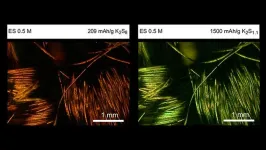(Press-News.org) About this study: A new review is the first to reveal the extent of human exposure to food contact chemicals (FCC), with 3,601 chemicals used in food packaging and other food contact articles having been found in human bodies. The authors say this review also highlights significant gaps in biomonitoring and toxicity data.
---
In a new study, published in the Journal of Exposure Science and Environmental Epidemiology, scientists describe the widespread human exposure to food contact chemicals (FCCs). The research reveals which chemicals used in food packaging and other food contact articles have been found in human samples, such as urine, blood, and breast milk. It also highlights significant gaps in biomonitoring and toxicity data. The data are made available in an interactive tool, the FCChumon database, which was compiled by a team of researchers from the Food Packaging Forum, together with colleagues from four academic institutions.
In a systematic approach, the authors compared over 14,000 known FCCs with data from five human biomonitoring programs, three metabolome/exposome databases, and scientific literature. This revealed evidence of 3,601 FCCs present in humans, representing 25% of the known FCCs. Dr. Birgit Geueke, first author of the study, emphasizes the importance of this work: “Our research establishes a link between food contact chemicals, exposure and human health. It also highlights those chemicals that have been overlooked in biomonitoring studies so far. And it offers an important opportunity for prevention and protection of health.”
Certain groups of chemicals, such as bisphenols, PFAS, phthalates, metals, and volatile organic compounds, have been widely detected in human samples and food contact materials (FCMs). Many of these chemicals have hazard properties of concern and have been linked to harming human health. Dr. Jane Muncke, senior author, expresses concern over this widespread exposure: “This work highlights the fact that food contact materials are not fully safe, even though they may comply with regulations, because they transfer known hazardous chemicals into people. We would like this new evidence base to be used for improving the safety of food contact materials – both in terms of regulations but also in the development of safer alternatives.”
Additionally, for other chemicals that transfer from the packaging into the food, such as synthetic antioxidants and oligomers, little is known about their presence and fate in humans. Dr. Ksenia Groh from the Swiss Federal Institute of Aquatic Science and Technology comments on this knowledge gap: “Our study highlights that antioxidants, despite their high production volumes and widespread use in plastics, are largely absent from monitoring programs. The knowledge about metabolism, fate, and effects of these substances is generally scarce.”
In addition to this, the study pointed out that many chemicals' potential hazards have not been sufficiently investigated. While food packaging is not the only source of exposure, the data from this study will improve the understanding of how food contact materials contribute to human exposure. It is likely that the actual number of FCCs present in humans is higher than currently detected because only a subset of FCCs was investigated in detail. Prof. Dr. Martin Scheringer, co-author from ETH Zürich, stressed the urgency of addressing this issue: “There are surprisingly many hazardous chemicals used in food contact materials, and they do not just stay there, but quite some of them reach, to some extent, the human body. This is concerning, and there clearly is a need for safer and simpler food contact materials.”
These results aim to help researchers focus on important gaps in our knowledge about human exposure to FCCs and better understand the health effects of these chemicals. As co-author Olwenn Martin from University College of London states, “we already knew that problematic chemicals in food packaging are not limited to well-known substances such as bisphenol and phthalates, but we were surprised by the high number of food contact chemicals for which some evidence of human exposure exists. This shows that there needs to be more research about the toxicity and exposure to many chemicals and regulation around their use in food packaging.”
All the data can be easily accessed and browsed in the accompanying Database on Food Contact Chemicals Monitored in Humans (FCChumon). FCChumon builds on the previously published Food Contact Chemicals Database (FCCdb) and Database on Migrating and Extractable Food Contact Chemicals (FCCmigex). This work is part of the Food Contact Chemicals & Human Health (FCCH) project.
END
Widespread evidence for packaging-related chemicals in humans
2024-09-17
ELSE PRESS RELEASES FROM THIS DATE:
Hardship early in life can affect health and longevity – even for marmots
2024-09-16
Key takeaways
The cumulative adversity index for people quantifies numerous measures of hardship, such as poverty and stress to understand health and longevity over the individual’s lifespan.
A similar tool could help scientists who study and want to conserve animal populations by identifying the most influential stressors to mitigate.
UCLA biologists have created the first cumulative adversity index for yellow-bellied marmots. They found that as in humans, adversity early on had lifelong consequences and reduced their life expectancy.
Adversity early in life can have permanent health consequences for people — even if their circumstances improve dramatically later on. ...
Chances of successful pregnancy are the same with embryo transfer on day three or five
2024-09-16
In IVF treatment, embryos are traditionally transferred in the uterus three days after fertilization. Due to improvements in laboratory techniques, this is now also possible after five days. It was assumed that this increases the chance of a successful pregnancy. A study by Radboud university medical center and Amsterdam UMC shows that the day of transfer does not influence the success rate of the IVF trajectory.
One out of thirty children in the Netherlands is conceived via in vitro fertilization, or IVF for short. In this procedure, ...
The Lancet: More than 39 million deaths from antibiotic-resistant infections estimated between now and 2050, suggests first global analysis
2024-09-16
Embargoed access to the paper and contact details for authors are available in Notes to Editors at the end of the release.
The Lancet: More than 39 million deaths from antibiotic-resistant infections estimated between now and 2050, suggests first global analysis
First in-depth analysis of global health impacts of antimicrobial resistance (AMR) over time reveals trends from 1990 to 2021 and estimates potential impacts to 2050 for 204 countries and territories.
More than one million people died from AMR globally each year between 1990 and 2021. Over the period, AMR deaths among children aged under five declined by 50% while those among people aged 70 ...
Fraunhofer IAF low-noise amplifiers aboard the Arctic Weather Satellite
2024-09-16
The Arctic Weather Satellite (AWS) of the European Space Agency (ESA) was sent on its journey to a polar orbit 600 km above the Earth on August 16, 2024. On board: four low-noise amplifiers (LNAs) from the Fraunhofer Institute for Applied Solid State Physics IAF in Freiburg. They are essential components of the passive microwave radiometer with which the AWS measures temperature and humidity in the Arctic more precisely than ever before. This should contribute to a better understanding of both the Arctic and the climate change that is particularly visible in it. If the mission is successful, ...
Immunotherapy after surgery helps people with high-risk bladder cancer live cancer-free longer
2024-09-16
Results from a large clinical trial show that treatment with an immunotherapy drug may nearly double the length of time people with high-risk, muscle-invasive bladder cancer are cancer-free following surgical removal of the bladder. Researchers found that postsurgical treatment with pembrolizumab (Keytruda), which is approved by the Food and Drug Administration (FDA) for treating at least 18 different cancers, was superior compared with observation. The study, led by researchers at the National Institutes of Health (NIH), ...
US COVID-19 rates oscillate every six months
2024-09-16
COVID-19 cases in the U.S. have shown unexpected oscillating waves every six months between the southern states and the northern states and, to a lesser degree, from east to west, according to new research published today in Scientific Reports.
Public health scientists from the University of Pittsburgh, University of Ottawa and University of Washington conducted the first detailed analysis to demonstrate and characterize the six-month oscillation of cases across space and time. It provides key information ...
Lower neighborhood opportunity may increase risk for preterm birth
2024-09-16
FOR IMMEDIATE RELEASE
Monday, September 16, 2024
Contact:
Jillian McKoy, jpmckoy@bu.edu
Michael Saunders, msaunder@bu.edu
##
Lower Neighborhood Opportunity May Increase Risk for Preterm Birth
A new study suggests that neighborhoods with fewer educational, health, environmental, and socioeconomic resources may increase one’s risk for preterm birth and contribute to the racial gap in preterm birth in the Commonwealth.
Preterm birth, defined as a live birth before 37 weeks of pregnancy, is the second-leading cause of infant mortality in the United States, and one that disproportionately affects Black and ...
Analysis finds cardiac devices recalled for safety reasons infrequently subjected to premarket or postmarket testing
2024-09-16
Embargoed for release until 5:00 p.m. ET on Monday 16 September 2024
@Annalsofim
Below please find summaries of new articles that will be published in the next issue of Annals of Internal Medicine. The summaries are not intended to substitute for the full articles as a source of information. This information is under strict embargo and by taking it into possession, media representatives are committing to the terms of the embargo not only on their own behalf, but also on behalf of the organization they represent.
----------------------------
1. ...
Trailblazers in plasma turbulence computer simulations win 2024 James Clerk Maxwell Prize
2024-09-16
A pair of physicists with long ties to PPPL are being honored for their foundational work on turbulence in plasma. Understanding why instabilities occur and how to limit them is critical to perfecting fusion as a stable energy source for the electrical grid.
Greg Hammett, a PPPL theoretical and computational principal research physicist, and Bill Dorland, former associate laboratory director for computational sciences and current Lab adviser, have won the 2024 James Clerk Maxwell Prize for Plasma Physics. The American ...
Technology could boost renewable energy storage
2024-09-16
Renewable energy sources like wind and solar are critical to sustaining our planet, but they come with a big challenge: they don't always generate power when it's needed. To make the most of them, we need efficient and affordable ways to store the energy they produce, so we have power even when the wind isn't blowing or the sun isn't shining.
Columbia Engineering material scientists have been focused on developing new kinds of batteries to transform how we store renewable energy. In a new study published September 5 by Nature Communications, the team used K-Na/S batteries that combine inexpensive, readily-found elements -- ...



